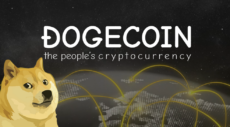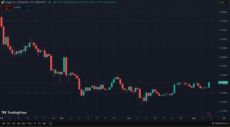Super Pepe (SUPEPE) is a 2025 meme coin with a charitable twist. In this post, you will discover some realistic price scenarios, a...
A look at Dogecoin’s rise from internet joke to serious cryptocurrency.
Key Notes:
- Dogecoin began as a parody of crypto hype but evolved into a top digital asset fueled by community support, internet culture, and celebrity endorsements.
- With its inflationary supply, low fees, and fast transaction times, Dogecoin is ideal for tipping, micropayments, and real-world experimentation.
- Despite its meme origins, Dogecoin challenges traditional views on value in crypto, proving that relatability and social consensus can drive adoption.
Dogecoin is one of the most unlikely success stories in digital finance. It is a cryptocurrency born from internet humor that grew into a multi-billion-dollar asset with real-world utility and cultural impact. Initially dismissed as a meme, Dogecoin has defied expectations through its passionate community, viral momentum, and ability to capture the imagination of both casual users and mainstream media.
This article explores how Dogecoin emerged, how it works, and what continues to fuel its enduring presence in the ever-evolving crypto landscape.
History of Dogecoin (DOGE) and Billy Markus
Dogecoin began as a lighthearted experiment in 2013, born from an internet meme featuring the popular Shiba Inu dog. Created by software engineers Billy Markus and Jackson Palmer, the coin was initially meant to poke fun at the growing hype around cryptocurrencies like Bitcoin. However, what started as a joke quickly gained traction, fueled by a passionate online community and viral culture.

Photo: Dogecoin Official Website.
Unlike Bitcoin, which was designed with a fixed supply, Dogecoin has an inflationary model with no maximum cap. This makes it better suited for tipping and microtransactions rather than long-term value storage. Its low transaction fees and faster block times have also contributed to its popularity among casual users.
Over the years, Dogecoin has transcended its meme origins. It gained mainstream attention through endorsements from celebrities like Elon Musk and was even used to fund charitable causes and sponsorships, from NASCAR drivers to clean water initiatives. Today, Dogecoin stands as a symbol of internet culture’s power to shape financial markets while raising questions about value, utility, and community in the crypto space.

Elon Musk tweeted about Dogecoin. Photo: X.
The Origins of Dogecoin
Dogecoin was launched in December 2013 by Billy Markus, an IBM software developer, and Jackson Palmer, who then worked at Adobe. The pair wanted to create a more approachable and fun alternative to Bitcoin — something that would demystify cryptocurrency and appeal to a broader audience. Inspired by the viral “Doge” meme — a Shiba Inu dog with Comic Sans captions and broken English — they turned an internet joke into a digital currency.
Technically, Dogecoin is based on Litecoin and uses the same Scrypt-based Proof-of-Work algorithm. It allows for faster block generation times and lower transaction fees, making it more efficient for small, everyday payments. But what truly set Dogecoin apart in its early days was its community. It quickly attracted a devoted group of internet users who used it for tipping content creators, crowdfunding causes, and supporting charitable efforts.
In many ways, Dogecoin’s origins reflect the spirit of early internet culture — irreverent, decentralized, and driven by grassroots participation. While it wasn’t designed to compete with Bitcoin on technical grounds, its viral appeal and loyal community laid the foundation for one of the market’s most resilient and recognizable meme coins.
How Does Dogecoin Work?
Dogecoin is an open-source cryptocurrency that operates on its own blockchain, using a decentralized, peer-to-peer network to validate and record transactions. Created in 2013, it relies on a Proof-of-Work (PoW) consensus — a mining system similar to Bitcoin — where miners produce new blocks by solving cryptographic puzzles and earn mining rewards in DOGE.
Unlike Bitcoin’s SHA-256 algorithm, Dogecoin uses the Scrypt algorithm, inherited from the Litecoin code. This Dogecoin feature enables a more accessible mining system for users with standard hardware. Since 2014, Dogecoin has been merged-mined with Litecoin, allowing both crypto assets to be mined simultaneously — a setup that improves efficiency and helps meet rising demand.
Dogecoin’s block time is only one minute, which can significantly increase transaction speed compared to Bitcoin’s 10-minute interval. Its inflationary model, with no maximum supply and 10,000 DOGE minted every minute, supports liquidity and spending. This built-in inflation also encourages activity among Dogecoin holders instead of hoarding.
Despite being inspired by a popular internet meme featuring a Japanese dog breed, Dogecoin has become a legitimate asset within the broader cryptocurrency community. It is often used for tipping quality content, microtransactions, and experimenting with blockchain payments on social media platforms and forums like Reddit.
Mining Dogecoin
Mining Dogecoin means validating transactions on its blockchain and receiving DOGE as mining rewards. The coin was created with accessibility in mind, using a mining system based on the Scrypt algorithm, making it easier to mine on GPUs than high-end ASICs, unlike Bitcoin.
Since its integration with Litecoin through merge mining, miners produce both coins simultaneously, creating an efficient process that boosts network security and reflects Dogecoin’s collaborative roots. This system, combined with its rapid block time and consistent rewards, ensures continuous participation from the mining community.
Dogecoin’s inflationary design — with no hard cap — differs from many other crypto assets and helps maintain active mining incentives. Every minute, a new block yields 10,000 DOGE, reinforcing the token’s supply and encouraging community-driven growth.
Prospective miners can opt for solo mining, which demands significant computational power, or join mining pools, which allow participants to share resources and earn steadier returns. For most new users, pool mining remains the most effective way to start earning DOGE and contributing to the network.
Dogecoin’s Community and Foundation
One of Dogecoin’s most enduring features is its vibrant and welcoming cryptocurrency community. From the start, Dogecoin hit a nerve with users across social media platforms and Reddit, where enthusiasts of the popular internet meme rallied around the coin not for profit, but for participation, humor, and support of quality content creators.
This community-driven ethos led to creative fundraising campaigns that gained mainstream attention, including sponsoring a NASCAR team, supporting clean water projects in Kenya, and even sending the Jamaican bobsled team to the Winter Olympics. These grassroots actions underscore Dogecoin’s ability to connect crypto culture with real-world causes and even comment on government efficiency.
To guide the ecosystem’s evolution, the Dogecoin Foundation — created in the early years and revived in 2021 — plays a central role in coordinating development, fostering adoption, and protecting the brand. Advisors like Ethereum co-founder Vitalik Buterin support its mission to promote sustainable innovation in open-source cryptocurrency development.
While the foundation doesn’t directly dictate the codebase, it offers critical structure to an otherwise decentralized network, amplifying the voices of Dogecoin holders and helping the project navigate discussions with regulators, developers, and financial institutions alike.
Dogecoin’s Market Performance
Dogecoin’s market trajectory has been anything but conventional. Initially launched without a serious investment thesis, DOGE traded for a fraction of a cent for several years, with minimal institutional interest. However, the token’s price and visibility surged in 2021, mainly driven by viral momentum, social media hype, and high-profile endorsements, most notably from Elon Musk, whose tweets repeatedly sparked dramatic price rallies.

Elon Musk tweeted about Dogecoin. Photo: X.
Currently, DOGE trades at a market price of DOGE $0.14 24h volatility: 0.8% Market cap: $22.87 B Vol. 24h: $1.16 B .

DOGE Price Chart. Photo: TradingView.
At its peak in May 2021, Dogecoin reached an all-time high of around $0.73, briefly securing a spot among the top five cryptocurrencies by market capitalization. This meteoric rise transformed DOGE from a niche internet joke into a multi-billion-dollar digital asset, attracting retail investors and media scrutiny. Yet, like many assets driven by speculative enthusiasm, Dogecoin’s price has also experienced significant volatility. After its 2021 highs, it entered a prolonged correction phase, in line with the broader crypto market downturn.
Despite fluctuations, Dogecoin has maintained a relatively strong presence in the market. As of early 2025, it ranks among the top cryptocurrencies by trading volume and remains listed on major exchanges, including Binance, Coinbase, and Kraken. Its high liquidity and low transaction fees make it appealing for active traders and as a base currency in meme coin ecosystems.
Dogecoin’s market performance underscores the power of community sentiment and viral narratives in the crypto space. While its long-term value proposition remains debated, DOGE has proven its staying power as more than just a passing meme — it’s a cultural and financial phenomenon in its own right.
How to Acquire Dogecoin
Buying Dogecoin is straightforward, thanks to its listing on nearly every major cryptocurrency exchange. Platforms like Binance, Coinbase, Kraken, and Robinhood allow users to purchase DOGE using fiat currencies such as USD or EUR and through trading pairs with Bitcoin, Ethereum, or stablecoins like USDT. For newcomers, centralized exchanges (CEXs) typically offer the easiest on-ramp, providing fiat gateways, user-friendly interfaces, and custodial wallet services.
For those who prefer a more decentralized route, DOGE can also be acquired via peer-to-peer (P2P) platforms or decentralized exchanges (DEXs), though liquidity may vary. Additionally, some crypto ATMs and payment platforms support Dogecoin purchases, further expanding access for users in certain regions.
Once acquired, storing Dogecoin securely is essential. While custodial wallets on exchanges offer convenience, they also expose users to platform risks. To maintain full control of their assets, many holders opt for non-custodial wallets — software wallets like Exodus or Trust Wallet offer support for DOGE. In contrast, hardware wallets like Ledger and Trezor provide enhanced security through offline storage.
As with any cryptocurrency, best practices include backing up wallet seed phrases, enabling two-factor authentication, and avoiding phishing attempts. Whether used for trading, tipping, or long-term holding, securing your DOGE is key to protecting your assets in the volatile world of crypto.
Dogecoin’s Role in the Cryptocurrency Market
Dogecoin occupies a unique and often paradoxical position within the cryptocurrency ecosystem. Originally launched as a satire of crypto speculation, it has evolved into one of the most recognizable digital assets in the world. While it lacks some advanced features and institutional infrastructure of platforms like Ethereum or Solana, Dogecoin has become a cultural and economic force, consistently ranking among the top cryptocurrencies by market capitalization and trading volume.
Dogecoin’s market role is defined less by technical innovation and more by community engagement, accessibility, and symbolic value. It is a gateway for newcomers to enter the crypto space, offering a low-cost, widely available asset with a strong meme-driven identity. Its fast transaction speeds and low fees make it suitable for tipping, micropayments, and experimenting with blockchain-based transactions.
Beyond utility, Dogecoin plays an essential role in shaping the narrative of crypto adoption. It challenges the notion that digital assets must be complex or purely utilitarian to gain traction. Instead, Dogecoin proves that social consensus, humor, and relatability can drive real-world value. It also acts as a stress test for the market — a barometer of sentiment, speculative behavior, and the power of internet culture to influence financial systems.
In this sense, Dogecoin is more than just a meme coin. It represents a decentralized social experiment, blurring the lines between entertainment, technology, and finance, and forcing the broader industry to reconsider what gives a cryptocurrency value.
Disclaimer: This article is for informational purposes only and does not provide financial, trading, or investment advice. Cryptocurrency prices can fluctuate wildly, so always do your own research (DYOR), assess risks, and consult a professional before making financial decisions. The author and team are not responsible for any losses from using this information.
FAQ
What is Dogecoin, and how did it originate?
Dogecoin is a cryptocurrency that started as a joke in 2013. Inspired by the viral Doge meme, Billy Markus and Jackson Palmer created it to parody the hype around Bitcoin. Despite its satirical origins, it gained a loyal community and real-world utility.
How does Dogecoin differ from Bitcoin and other cryptocurrencies?
Dogecoin uses the Scrypt algorithm instead of Bitcoin’s SHA-256, offers faster block times (1 minute vs. 10), and has no maximum supply, making it inflationary and better suited for microtransactions.
What are the key features of Dogecoin's blockchain?
Dogecoin’s blockchain is open-source, uses Proof-of-Work consensus, supports merge mining with Litecoin, and generates 10,000 DOGE per block every minute.
How can I mine Dogecoin, and what equipment is needed?
Dogecoin can be mined solo or via mining pools using GPU hardware or ASICs compatible with Scrypt; most miners today merge-mine DOGE with Litecoin for efficiency.
What is the role of the Dogecoin Foundation?
The Dogecoin Foundation supports core development, legal protection, and ecosystem growth, acting as a steward for the project’s long-term sustainability without directly controlling the network.
How has Elon Musk influenced Dogecoin's popularity?
Elon Musk’s tweets and public endorsements have repeatedly spiked Dogecoin’s price and visibility, positioning him as the community’s unofficial figurehead.
Where can I buy Dogecoin, and how do I store it securely?
You can buy Dogecoin on exchanges like Binance, Coinbase, or Kraken, and store it securely using hardware wallets like Ledger or software wallets like Exodus or Trust Wallet.
What factors influence Dogecoin's price fluctuations?
Dogecoin’s price is influenced by market sentiment, social media trends, endorsements from public figures, broader crypto market movements, and its unlimited supply model.
Is Dogecoin a good investment compared to other cryptocurrencies?
Dogecoin is highly speculative and driven by community hype rather than fundamentals, making it riskier than utility-driven projects but appealing to those seeking meme-driven market momentum.
What is the future outlook for Dogecoin in the crypto market?
Dogecoin’s future depends on continued community support, integration into payment systems, and sustained cultural relevance, though its lack of technical innovation poses long-term challenges.
Coinspeaker in Numbers
Monthly Users
Articles & Guides
Research Hours
Authors
AlphaPepe has quickly become one of the more talked-about meme presales, thanks to the instant token delivery, active community, a...
In this guide, we explain how to purchase MoonBull tokens through the presale, explore the project's meme-meets-DeFi mechanics.
 10 mins
10 mins
Tony Frank
Crypto Editor, 56 postsTony Frank is an accomplished cryptocurrency analyst, author, and educator whose work bridges the gap between complex blockchain technology and accessible, actionable insights for global audiences. Over the past decade, he has emerged as a respected voice in the rapidly evolving world of digital assets, combining technical expertise with a talent for storytelling to help readers navigate everything from Bitcoin’s monetary philosophy to the intricacies of decentralized finance (DeFi). Tony earned his Bachelor’s degree in Economics and Finance from the University of Melbourne, where he developed a deep interest in monetary systems and market structures. He later pursued a Master’s degree in Blockchain and Digital Currency from the University of Nicosia, one of the first academic institutions to offer accredited programs in cryptocurrency studies. Before focusing full-time on blockchain, Tony worked as a financial analyst for a multinational investment firm, covering emerging technologies and alternative asset classes. His early exposure to macroeconomic policy, global market behavior, and fintech innovation laid the foundation for his later work in crypto research and writing. Tony’s expertise spans multiple sectors of the blockchain industry, including cryptocurrency fundamentals, altcoin market cycles, DeFi and web3 trends and regulatory landscapes. Tony combines on-chain data analysis with macroeconomic research, providing readers with both the technical “how” and the market “why” of cryptocurrency movements.